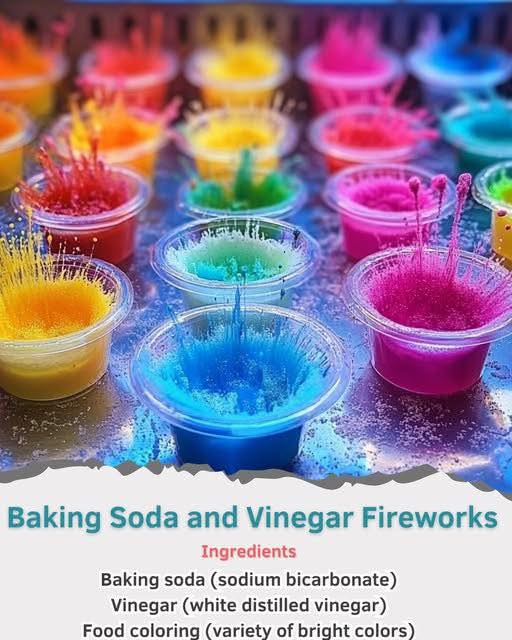Ever wondered how to create a mini volcano or a fizzy eruption right in your kitchen? Well, you’re in the right place! We’re diving into the fun and exciting world of baking soda and vinegar fireworks – a safe, simple, and totally awesome science experiment that you can do with everyday household items. Get ready to unleash your inner scientist!
What’s the Buzz About Baking Soda and Vinegar Reactions?
It might sound like kitchen chemistry, but the reaction between baking soda and vinegar is a classic science experiment that’s both educational and entertaining. We’ll break down the science behind the fizz and show you how to create your own mini eruptions. Think of it as a DIY science show right in your home!

The Science Behind the Fizz
Okay, let’s get a little scientific. Baking soda, also known as sodium bicarbonate (NaHCO3), is a base. Vinegar, on the other hand, is a dilute solution of acetic acid (CH3COOH). When these two meet, a chemical reaction occurs, producing carbon dioxide gas (CO2), water, and sodium acetate.
- Baking Soda (Sodium Bicarbonate): The alkaline ingredient.
- Vinegar (Acetic Acid): The acidic ingredient.
- Carbon Dioxide (CO2): The gas responsible for the fizz and eruption.
That CO2 is what causes all the bubbling and, with a little creative setup, can create a pretty impressive “firework” display!

Simple Baking Soda and Vinegar Fireworks: The Eruption Test
Ready to make your own eruption? Here’s a basic recipe to get you started:
- Gather your supplies: You’ll need baking soda, vinegar, a container (like a plastic bottle or cup), and optionally, some food coloring for extra flair.
- Pour in the vinegar: Fill your container about halfway with vinegar.
- Add the baking soda: Quickly add a few spoonfuls of baking soda. Stand back!
- Watch the magic: The mixture will fizz and bubble, creating a mini “eruption.”
For a more dramatic effect, try adding a few drops of dish soap to the vinegar before adding the baking soda. This will create even more bubbles!

Level Up Your Baking Soda and Vinegar Fireworks
Now that you’ve mastered the basic eruption, let’s explore some ways to make your baking soda and vinegar fireworks even more spectacular. Think color, height, and sound!

Rainbow Eruptions: Adding Color to the Fun
Want to add a splash of color to your experiment? It’s easy! Simply add a few drops of food coloring to the vinegar before mixing it with the baking soda. You can create a rainbow effect by using multiple containers, each with a different color.
- Red: Classic and fiery!
- Blue: Ocean-like and mesmerizing.
- Green: Earthy and natural.
- Combine colors: Get creative and mix colors for unique effects.
Experiment with different color combinations to see what kinds of dazzling eruptions you can create!

The Bottle Rocket Blast: Increasing the Pressure
For a bigger blast, try creating a “bottle rocket” effect. You’ll need a plastic bottle with a cap, baking soda, vinegar, and some paper towels or tissue paper.
- Pour vinegar: Pour vinegar into the bottle.
- Wrap baking soda: Wrap a few spoonfuls of baking soda in a paper towel or tissue.
- Insert and seal: Quickly drop the baking soda package into the bottle and seal the cap tightly.
- Stand back: The pressure will build up, and eventually, the cap will pop off with a bang!
Safety Note: This experiment should be done outdoors and with adult supervision. Make sure the bottle is pointed away from people and objects.

Mini Volcano: Build a Paper Mache Volcano
Let’s get crafty! Building a mini volcano out of paper mache adds another dimension to your baking soda and vinegar firework display. You can use a plastic bottle as the base for your volcano.
* Materials: Plastic bottle, newspaper, flour, water, paint.
* Instructions:
1. Create a paper mache paste by mixing flour and water.
2. Cover the plastic bottle with layers of newspaper dipped in the paste.
3. Let it dry completely.
4. Paint your volcano to make it look realistic.
5. Place your volcano on a tray or outside.
6. Pour vinegar into the volcano’s opening.
7. Add baking soda and watch the eruption!

Conclusion: Explore the World of Kitchen Science
Baking soda and vinegar fireworks are a fantastic way to introduce the principles of chemistry to kids (and adults!) in a fun and engaging way. By understanding the science behind the fizz and experimenting with different setups, you can create spectacular eruptions and spark a lifelong love of learning. So, gather your supplies, put on your lab coat (optional), and get ready to explore the exciting world of kitchen science!

